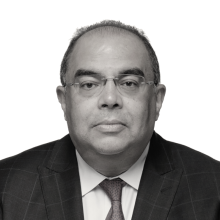
Sébastien Thibault for FP Analytics
With economic instability threatening a growing number of debt-saddled low- and middle-income countries, the United Nations Expert Group on Debt was established in late 2024 and four experts were tasked with finding actionable solutions to the global debt crisis. The group’s work culminated in a June 2025 report, Confronting the Debt Crisis: 11 Actions to Unlock Sustainable Financing, which complements the outcome document of the International Conference on Financing for Development (FfD) in Seville, Spain.
Ahead of the conference, FP Analytics spoke with the group’s leader, Dr. Mahmoud Mohieldin, to discuss the ideas being generated, why it’s called a “silent debt crisis,” and why political feasibility is one of the most important characteristics of a practical solution. The following transcript has been edited for length and clarity.
FP Analytics (FPA): What are the U.N. Expert Group on Debt’s key priorities for debt relief and reform, whether dealing with a type of debt or an acute need in a specific country or region?
Mahmoud Mohieldin (MM): The key priorities are practical solutions for managing debt and navigating the current crisis, and this is very much what we are preparing for the Financing for Development conference.
The four of us—myself; Paolo Gentiloni, the former prime minister of Italy; Trevor Manuel, the former Minister of Finance of South Africa; and scholar Yan Wang, who is associated with the Boston University Global Development Policy Center—have been mandated with providing guidance and suggestions to the U.N. system and informing the FfD process with a focus on the distressed countries in Africa and small island developing states (SIDS) around the world. It’s about getting all of the existing proposals—from governments or international government organizations, like the World Bank and the International Monetary Fund (IMF), or agencies of the U.N. system, or independent thinkers and think tanks, or practitioners—together and putting them in a hierarchy of priorities.
To be considered practical solutions, they need to go through two filters. First, they need to be based on good analytics, good assessments. And second, the suggestions and proposals, which should undergo a qualitative assessment, need to be politically plausible or feasible.
You are aware of the interesting dynamics in the global system today, and there are many ideas that could be technically feasible but require political feasibility as well. So we are engaged with the top technicians, but we’re also engaged with governments from all over the world. On a weekly basis, we have been engaged directly and in communication with those who have been behind all of the proposals you have been hearing about, including the Jubilee initiative by the late Pope Francis.
FPA: Are there any specific areas or challenges that you and your colleagues have identified as being the most universal or the most in need of innovation and change?
MM: I think at the very beginning, it was about identifying the problem we’re trying to solve and whether the term “debt crisis” described the case or not. And it’s a “silent debt crisis,” quoting recent World Bank research, that takes from essential investments in human capital like education and health and infrastructure, which should be a priority for any country or any government, in order to provide debt service.
There are a lot of good assessments, including the World of Debt report of the U.N. Conference on Trade and Development (UNCTAD), that demonstrate not just the usual indicators—debt-service ratios or debt-to-GDP ratios—but how the debt service, or the interest alone, is costing many countries.
And these countries are not proposing solutions because they are concerned that if they send a signal of a need for solutions, it could be harmful to access to markets or access to creditors. That’s why the debt crisis is silent.
The IMF reminds us that it’s not a global debt crisis of the type we saw during the global financial crisis, but still, the number of countries in debt distress has been on the rise. And with the lower growth and high inflation we have seen over the past few years, many of these countries are shouldering an increasingly heavy burden.
Another issue is that, because of the time it takes for debt management or debt restructuring under the common framework, everybody is admitting that the Common Framework of the G20 needs to be accelerated and needs to be more inclusive by bringing in the middle-income countries. More than half of the African countries and the majority of the SIDS cases that we deal with are not low-income, based on the criteria used by the U.N. They are middle-income countries. So we need to be more inclusive.
And then there is the question of: Is it a liquidity crisis or an insolvency crisis? It could really be helpful to address problems at the liquidity stage before it deteriorates into insolvency trouble. Because the cure, as you know, would be very different if we catch it earlier. If we’re late, countries take years until they can recover.
We went through a series of proposals that we grouped into categories—what could be done at the national level and what could be done through international cooperation at the global level.
FPA: What ongoing or proposed efforts for debt reform and relief do you see as particularly promising, whether that’s at the national level, regionally, or more globally?
MM: First, we’re happy with the three-pillar approach of the IMF and the World Bank, like putting the house in order of the country concerned, enhancing the role of international financial institutions to support and consider different options of debt relief. This is very much a common-sense approach. We are focusing the work as well on the debt sustainability analysis. But by that we are requesting not just the debt sustainability analysis for low-income countries but for countries with market access, which is not currently under review. We need that to be considered by the IMF and the World Bank.
Another measure is related to what you see in the FfD outcome document that is under discussion now in preparation for Seville and what is being proposed by the host, Spain. First is the variety of tool kits that are available today, including the consideration of debt-for-climate, debt-for-nature, and debt-for-development swaps. There are proposals by the host to create a kind of a hub along with the World Bank to build a pipeline of swappable debt. Then there is the consideration that came in different forms—from the Paris pact to the proposition of the Bridgetown Initiative to the climate summit—for countries facing pressure or shocks or catastrophes to benefit from a debt-service pause. And here it’s not limited only to natural catastrophe but any kind of major shocks that could be considered for providing debt-service suspension or debt-service pause.
There is an idea as well to consider the use of the undistributed and unutilized special drawing rights (SDRs) to form a fund. This could be part of the liquidity management to buy back debt from countries facing challenges. There are also suggestions for the World Bank to replenish the existing debt-reduction trust fund and for other multilateral development banks (MDBs) that do not have such funds to create them. Because there have been requests, especially from some of the emerging creditors, that if they are flexible in accommodating debt-restructuring solutions, they are expecting the MDBs to do the same. We have some lessons from the Heavily Indebted Poor Countries (HIPC) Initiative as far as keeping the net present value of the debt neutral. But for that neutrality to occur, you need a third-party injection of funds like a country or even a foundation to contribute to these MDBs to do the kind of work to accommodate the demands for debt restructuring. There have also been ideas related to enhancing capacity-building for countries to improve their debt-management offices and improve the coordination among treasuries, central banks, and other entities.
Finally, there is a proposal that comes in different shapes on forming a foreign policy platform. It could be establishing a borrower’s club or a debtor’s club, or someone called it the “South Club.” It’s basically about technical assistance, capacity-building, and knowledge-sharing between countries. They could benefit from sharing ideas, not just regarding similar tough situations of those in debt distress, but countries that faced something similar decades ago, like Korea or some emerging markets that are doing better, could share lessons they learned from mistakes of the past.
But there are other suggestions and proposals, and we haven’t reached a final decision yet. This is my own personal view but not an opinion of the whole group.
FPA: Of the ones you mentioned and you personally are interested in, are there any that strike you as more politically feasible?
MM: All of these measures, I hope without exception, are politically feasible. There are other measures that may require more political support, but we are talking about what we need to have in the immediate years of implementation after Seville. We’re not talking about beyond 2030 or even beyond 2028. We are focused on what could be implementable the day after Seville or even before if the ideas have some appeal.
Requesting from some particular creditor countries to provide debt relief by “haircuts” may not always be feasible across the board. A more generous haircut for countries of similar circumstances may not be accepted given that there is a preference for dealing with cases one by one. And there is a logic to that. When countries borrowed, they borrowed individually, not as a group, so they need to be dealt with individually to prevent moral hazard, or adverse risk selection, or complicating matters more than what’s needed.
There are other proposals that require an immediate increase of capital of the MDBs. We recognize it and we might be pushing for it because this is part of the three-pillar approach of the IMF and the World Bank. But in the end, we’re trying to reach solutions that are technically feasible and politically feasible by consensus as well.
FPA: What kinds of reforms to international financial institutions do you believe are necessary to complement these more short-term debt-relief efforts in order to drive sustainable development without causing severe debt-service burdens in the future?
MM: There have been a great number of lessons learned for such a crisis not to occur again, but we still repeat the same mistakes. I think this has less to do with the development model and more to do with the growth model in some countries that is very much dependent on debt instruments. And we have learned that debt, even if it is concessional long-term, still has a risk associated with it if you are borrowing from foreign currency. So it’s basically about how the growth model could improve in the future for it to be more dependent on long-term finance, realizing the importance of the economic as well as the social returns, relying more on the private sector to do what it can, especially in infrastructure projects. We have seen a greater understanding of the value of public-private partnerships in many countries, including in Africa. So there are many solutions that could deal with the issue of how to sustain funding for development without compromising soundness and the sustainability of the country’s debt. It’s basically about how you originate the funding to start with.
Any kind of generous assumption that there is going to be someone somewhere to bail you out, I think, has been diminishing recently because of the tough politics. I remember when I was preparing for COP27 in Egypt saying that climate finance like development finance suffers from being insufficient because we are aware of the gaps in funding and how the gap is widening between what’s needed for the Sustainable Development Goals and what’s available, even if you do everything related to domestic resource mobilization right. And it’s insufficient and inefficient as well because it takes forever until you mobilize funding, and in many cases it’s unfair because of the cost of borrowing. I said that back in 2022 in the context of climate finance. But I think my argument could still, unfortunately, be valid because the gap has widened since then and the efficiency didn’t improve much.
FPA: Do you see the role or priorities of the Expert Group on Debt changing over time? If so, how?
MM: Within the mandate, we insisted not just to put a list of good wishes under a Christmas tree but basically to have this kind of very useful filter of the political plausibility of the proposals. And that has evolved with us nicely. Even with the changes that we had seen, I don’t think that any of the measures had to be dropped because we’re very much aware that the landscape, including the political landscape, has been evolving to a direction that we need to be factoring in. At the beginning, I remember there was a bit of resistance because if you are going to rush all of that, you might be accused of not being ambitious enough. But we need to not let the perfect be the enemy of the good. And there are good things, as I mentioned, that could be implemented.
There have been a great deal of ideas coming our way because people understand the seriousness of this project. The suggestions and proposals have been sent to us from all over, not just from the usual places, but there are many centers from the Global South, including from Africa, that have been very active with us. And I think the composition of the group, with people from Italy, from China, from Africa, has been very helpful to get all of these suggestions, and I hope it will be put into action fast. And then this issue of the club, everybody has been talking about it, especially within Africa and the Global South countries, on how to have this kind of borrower’s club or forum. So we are proposing some suggestions for such a club, including the operationalization of responsible borrowing and lending practices, that have been put forward in the discussions at the U.N. within the FfD discussions for Seville.
Dr. Mahmoud Mohieldin is the U.N. Special Envoy on Financing the 2030 Agenda for Sustainable Development. He is a Professor of Economics at Cairo University, a nonresident Senior Fellow at Brookings Institution, a visiting senior research scholar at Columbia Business School, a fellow of the World Academy of Art and Science, the co-chair of the World Economic Forum’s Global Future Council on the Business of Economic Growth, and a member in the Leadership Council of the U.N. Sustainable Development Solutions Network. Mohieldin was the first Minister of Investment of Egypt (2004–2010), served as Senior Vice President of the World Bank Group and Executive Director at the IMF, and was the U.N. Climate Change High Level Champion for COP27.
More on Debt Architecture
Fixing Foreign Aid
Episode 1: How have the recent cuts in foreign aid impacted countries in the global south? And how did so many countries become reliant on foreign aid to begin with?
Tackling Sovereign Debt
Episode 2: How can we ensure countries looking to finance their future don’t have to mortgage away their present?
Reforming Global Finance
Episode 3: What can the World Bank and International Monetary Fund do to ensure more countries from the global south have a seat at the table?




